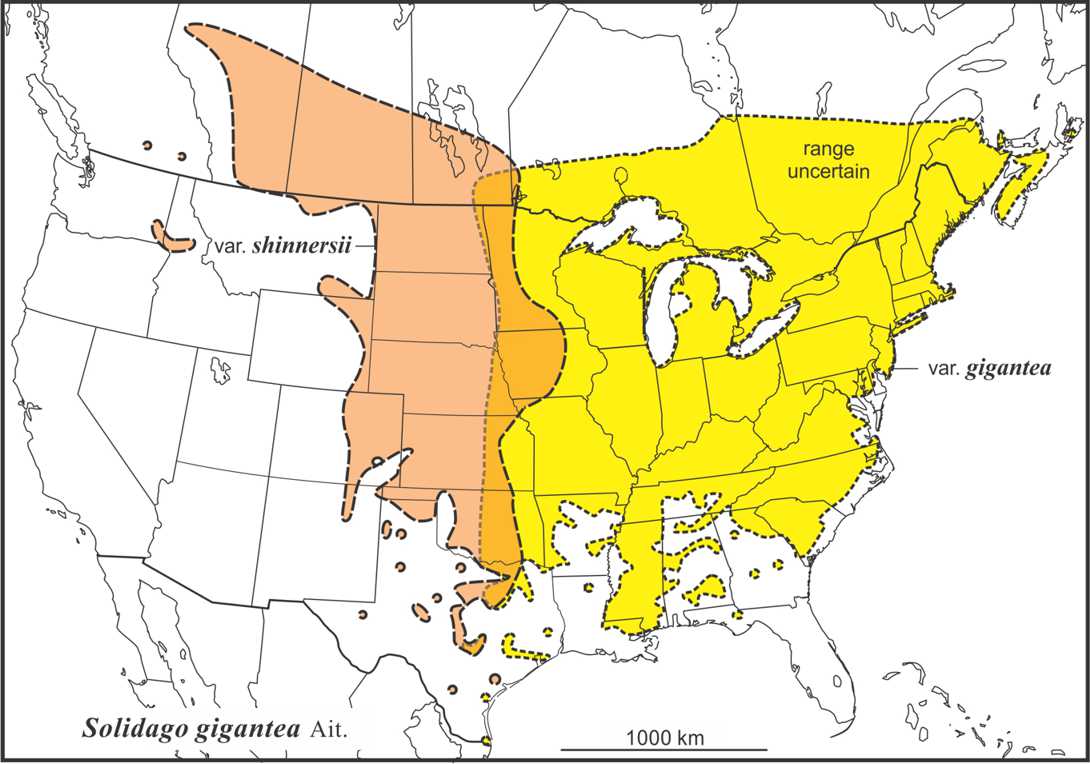Tall or Giant or Smooth Goldenrod, verge d’or géante
Solidago gigantea Ait. is native to at least seasonally moister soils, flood plains, ditches, depressions, open woods, and thickets of eastern Canada and the U.S. and moist depressions in grasslands and parklands on the Great Plains. It is usually the least hairy species of the S.canadensis complex, and has a more open branched, broadly secund conical inflorescence that is less leafy than S. lepida var. lepida (Semple & Cook 2006 FNA).
Work done since FNA revealed that S. gigantea can be sometimes somewhat glandular in the inflorescence making it harder to separate from S. lepida. In a large prelimary multivariate study by the Astereae Lab, S. gigantea and S. lepida did not separate as well as expected using degree of glandularity to define the species. Published results were much stronger when specimens were assigned to S. gigantea on the basis of the inflorescence branching pattern, i.e. "looked like S. gigantea" (Semple et al. 2017). Cronquist (1994) stated that S. gigantea was clearly distinct from the S. canadenis/lepida complex, but sparsely glandular tetraploids (2InI=36) in New Brunswick can be similar to S. fallax var. fallax, and hexaploids on the western edge of the Great Plains and into the mountains in British Columbia, Washington, Idaho and Montana can be difficult to distinguish from S. lepida var. salebrosa. There also appear to be some hybrids between S. lepida and S. gigantea var. shinnersii in Alberta, Saskatchewan, and Manitoba along the forest-prairie ecotone.
Several varieties have been described within the species. The hexaploid prairie plants are treated here as S. gigantea var. shinnersii Beaudry (syn: S. shinnersii (Beaudry) Beaudry). Solidago gigantea var. leiophylla Fern. includes plants with smooth leaves lacking hairs on both surfaces. Neither variety was recognized by Semple and Cook (2006 FNA). The following are treated as synonyms of the typical eastern var. gigantea: Aster latissimifolius (Miller) Kuntze var. serotinus Kuntze; Doria dumetorum (Lunell) Lunell; D. pitcheri (Nuttall) Lunell; Solidago cleliae DC.; Solidago serotina Ait. f. huntindonensis Beaudry; S. gigantea var. leiophyllaFernald; S. gigantea subsp. serotina (Kuntze) McNeill; S. giganteavar. serotina (Kuntze) Cronquist; S. pitcheri Nutt.; S. serotina Ait. 1789, not Retzius 1781; S. serotina var. gigantea (Ait.) A. Gray; S. serotina var. minor Hook.; S. serotinoides Á. Löve & D. Löve; S. somesii Rydberg.
Multivariate work by Semple et al. (2017) on S. gigantea indicates support for recognizing the broader leaved hexaploid as S. gigantea var. shinnersii: syn: S. shinnersii (Beaudry) Beaudry. This variety is found across the prairies and into the valleys of southeastern British Columbia, eastern Washington, northern Idaho and western Montana. The typical variety is eastern and diploid (2n=18) and tetraploid (2n=36). Martino et al. (2020) concluded that overlaps in ranges of morphological traits did not support recognition of var. shinnersii, based on the traits considered by their study. Further work is needed.
Semple et al. (1984) summarized the pattern of ploidy distribution in the species based on a limited sample size concluding that diploids were confined to a zone running from eastern Texas to Nova Scotia but absent for the most part in the midwestern states. After several more decades of sampling, it is now clear that diploids in var. gigantea occur through much of the range of the variety but are less common than tetraploids accept in the southeastern portion of the range on the outer piedmont and coastal plain where diploids are most common or exclusive. Hexaploids (2n=54) occur on the prairies and into the mountains in the Pacific northwest; these are all var. shinnersii. Morton et al. (2019) published chromosome number counts for 154 individuals of Solidago gigantea from Canada, England, France, and the United States. A very large sample size was used in Martino et al. (2020) who combine published chromosome count data and DNA sequence data SNP indicators of ploidy level to explore ecological features of diploid, tetraploid and hexaploid cytotypes across the species's range in North America. Martino et al. (2020) found more habitat differences separating hexaploids from the other ploidy levels, while habitat differences between tetraploids and diploids occurred but were weaker. This indicates that the evolution of hexaploidy in S. gigantea allowed the species to greatly expanded its range westward.
Solidago gigantea was not included in the treatment of Solidago in the Flora of China (Chen and Semple 2011). However, an image posted on Chinese web site (© Benjamin Liu) seen more recently clearly shows that the species is present in China as an invasive and is like tetraploid. Solidago gigantea is invasive in Europe, Japan, South Africa and other locations.
Solidago gigantea was included in strongly supported clade S. sect. Unilaterales subsect. Serotinae (Rydb.) Semple & J.B. Beck along with S. chilensis and S. microglossa (Semple and Beck 2021; Semple et al. 2023).
Last revised 16 April 2025 by J.C. Semple
© 2025 J.C. Semple, including all photographs unless otherwise indicated
1-8. Solidago gigantea. 1-5. var. gigantea. 1. Tall plants, Blue Ridge, North Carolina. 2. Open, few branched inflorescence, Semple 11523, New Brunswick. 3. Smooth, waxy stem, Nova Scotia. 4. Stem leaf, S 11523. 5. Var. shinnersii, Morton NA14215 TRT, Manitoba. 6. Heads, Blue Ridge, North Carolina. 7. Shoots along Rhine R., Cologne, Germany. 8. Range map.
Semple, J.C., H. Faheemuddin, M. Sorour, and Y.A. Chong. 2017. A Multivariate studies of Solidago subsect. Triplinerviae in western North America: The Solidago lepida complex (Asteraceae: Astereae). Phytoneuron 2017-47: 1–43.
Morton, J.K., J. Venn and J.C. Semple. 2019 [2020]. Chromosome number determinations in Solidago gigantea (Asteraceae: Astereae). Rhodora 121 (4): 347-352.
Martino, M., J.C. Semple, and J.B. Beck. 2020. Two cytoype niche shifts are of different magnitude in Solidago gigantea. Amer. J. Bot. 107: 1567-1576. https://doi.org/10.1002/ajb2.1556
Semple, J.C. and J.B. Beck. 2021. A revised infrageneric classification of Solidago (Asteraceae: Astereae). Phytoneuron 2021-10. 1-6.
Semple, J.C., McMinn-Sauder, H., Stover, M., Lemmon, A., Lemmon E., and J. B. Beck. 2023. Goldenrod herbariomics: Hybrid-sequence capture reveals the phylogeny of diploid Solidago. Amer. J. Bot. 110: e16164. https://doi.org/10.1002/ajb2.16164















